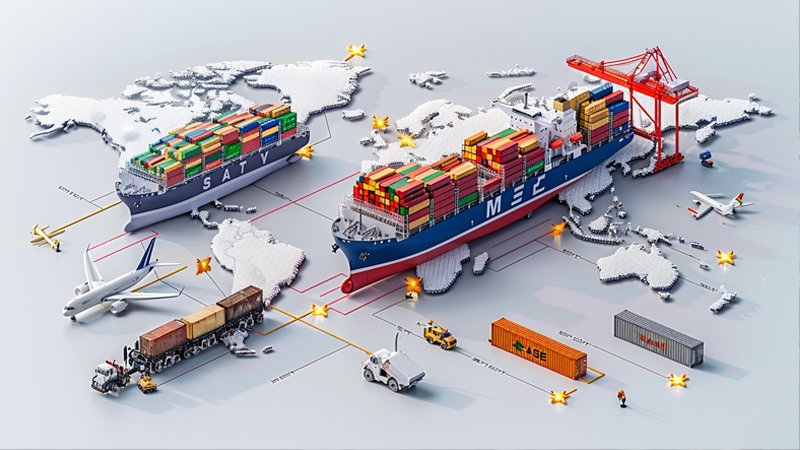
I recently discovered simple, practical strategies to reduce shipping costs from China to the USA, saving both money and time.
Practical tips, cost-effective shipping methods, bulk shipping, and smart negotiation strategies are key to avoiding extravagant shipping costs from China to the USA.
Let's explore these effective strategies together.
What practical tips can help you reduce shipping costs from China to the USA?
I found that small changes in packaging, planning, and documentation can dramatically cut shipping expenses.
Practical tips include optimizing packaging, negotiating better rates, and using technology to manage shipments efficiently.

When I first started exploring ways to reduce shipping costs, I quickly realized that the little details make a huge difference. One of the simplest tips is to optimize your packaging. By using standardized box sizes and reducing excess packaging material, you can lower both weight and volume charges. I learned that proper documentation is just as important—accurate and complete paperwork helps avoid delays and additional fees at customs.
Another tip is to plan shipments well in advance. This gives you the flexibility to choose off-peak times when freight rates are lower. I also found that consolidating smaller orders into one shipment can significantly reduce costs, as it minimizes handling fees and takes advantage of bulk pricing. Additionally, leveraging technology such as online freight calculators and real-time tracking systems helps me compare different carriers and choose the most cost-effective option.
Communication with your logistics partners is key. I always ask for detailed quotes and compare them, ensuring no hidden fees creep into the final cost. Over time, these practical adjustments have led to noticeable savings.
| Tip | Benefit |
|---|---|
| Optimized Packaging | Lower weight and volume charges |
| Accurate Documentation | Avoids delays and extra fees |
| Advanced Planning | Access to lower off-peak rates |
| Consolidated Shipments | Reduces handling and per-unit costs |
These tips, combined with careful research, have empowered me to significantly reduce my shipping costs.
Which shipping methods are the most cost-effective for China to USA transport?
I discovered that choosing the right mode of transport is essential to balancing cost and delivery speed.
Cost-effective methods typically include sea freight and rail shipping, which offer lower rates compared to air freight for non-urgent shipments.

In my experience, the shipping method you choose can make a major difference in cost. Sea freight, for example, is usually the most economical option for large shipments. Although it has longer transit times, the cost per unit drops significantly when shipping in bulk. I’ve also seen rail shipping1 emerge as a reliable alternative for goods moving from China to the USA, offering a middle ground between speed and cost, especially for inland deliveries.
Air freight, while faster, tends to be much more expensive and is best reserved for high-value or urgent items. When selecting a shipping method, I always consider factors such as the volume of goods, the required delivery timeline, and the overall value of the shipment. Using a combination of these methods can sometimes yield the best results—for instance, using sea freight2 for the bulk of a shipment while sending a few urgent items via air.
Technology also plays a role here; many logistics providers offer integrated platforms where you can compare different routes and methods. I often run cost-benefit analyses before finalizing a method, weighing the savings against the potential delay. This approach ensures that I choose a method that aligns with both my budget and delivery expectations.
| Shipping Method | Key Benefit |
|---|---|
| Sea Freight | Lowest cost for high-volume shipments |
| Rail Shipping | Balanced speed and cost |
| Air Freight | Fastest, but highest cost |
Selecting the right method is about balancing cost and urgency, which is vital for effective supply chain management.
How can bulk shipping help you save on transportation expenses?
I realized that shipping in bulk significantly reduces per-unit costs and streamlines logistics processes.
Bulk shipping consolidates orders, reducing handling fees and lowering overall costs by leveraging economies of scale.

In my journey to cut down on shipping expenses, bulk shipping has proven to be a game-changer. When you combine multiple orders into a single shipment, you can take advantage of economies of scale3 that lower the cost per unit. I’ve experienced firsthand that consolidating goods not only minimizes handling fees but also reduces the frequency of shipments, which in turn lowers overall transportation expenses.
One effective strategy is to coordinate with suppliers and other businesses to share container space. This method, often referred to as Less-than-Container Load (LCL) shipping4, allows you to benefit from bulk rates without having to fill an entire container yourself. Alternatively, if your volume permits, Full Container Load (FCL) shipping offers even greater savings and fewer handling risks.
I also found that bulk shipping simplifies documentation and customs clearance because you’re managing one large shipment instead of multiple smaller ones. The benefits extend to improved inventory management and better planning for production schedules. In addition, many freight forwarders offer discounts for regular, bulk shipments, which further drives down costs.
| Bulk Shipping Aspect | Advantage |
|---|---|
| Economies of Scale | Lower per-unit shipping costs |
| Reduced Handling Fees | Fewer shipments mean less frequent fees |
| Simplified Documentation | One consolidated set of paperwork |
| Supplier Collaboration | Shared container costs with partners |
By optimizing bulk shipping, I’ve been able to achieve significant cost savings and more efficient logistics management.
What negotiation strategies can you use to secure better shipping rates?
I learned that smart negotiation can play a crucial role in reducing shipping expenses5.
Effective negotiation involves leveraging volume commitments, comparing multiple quotes, and building long-term relationships with carriers.

Negotiating shipping rates is both an art and a science. I started by gathering multiple quotes from different carriers to understand the market rate. This approach gave me a solid baseline and room to negotiate for better terms. Volume commitments also come in handy—if you plan to ship regularly, using that promise as leverage often results in discounts and preferential rates.
Building a strong relationship with your logistics partner is another strategy I found invaluable. Open communication and trust can lead to more flexible terms, especially during peak seasons when shipping costs tend to spike. I make sure to highlight my long-term business potential during negotiations. Sometimes, offering to sign a longer contract in exchange for lower rates is a win-win solution.
It’s also important to stay informed about market trends and seasonal fluctuations. I routinely check industry news and rate indexes, which helps me time my negotiations more effectively. Additionally, I ask for a breakdown of all costs so I can identify areas for further savings—be it through reducing surcharges or eliminating redundant services.
| Negotiation Tactic | Benefit |
|---|---|
| Multiple Quotes | Establishes a competitive baseline |
| Volume Commitment | Unlocks bulk discounts and lower rates |
| Long-Term Contracts | Secures favorable terms over time |
| Cost Breakdown | Identifies areas to cut unnecessary fees |
Using these negotiation strategies, I’ve successfully lowered my shipping costs and built lasting partnerships with reliable carriers.
Conclusion
Smart strategies, bulk shipping, and effective negotiation are essential to avoiding extravagant China-USA shipping costs.
-
Learn about rail shipping as a reliable alternative that balances speed and cost, especially for inland deliveries. ↩
-
Explore the advantages of sea freight, especially for large shipments, to understand how it can save costs significantly. ↩
-
Learn how economies of scale can significantly reduce shipping costs and improve efficiency in logistics. ↩
-
Discover the benefits of LCL shipping and how it can help you save on shipping costs without filling an entire container. ↩
-
Explore this resource to discover proven methods for cutting shipping costs and improving your logistics strategy. ↩




